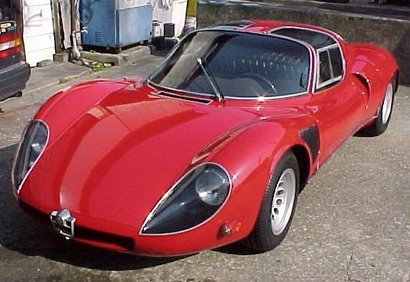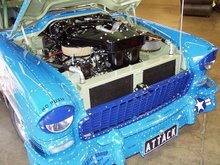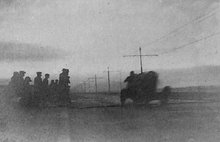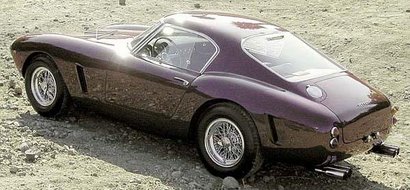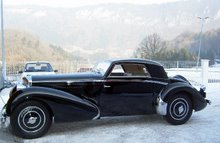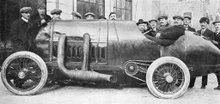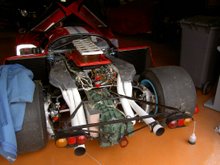Just looking at HTML makes my heart sink, whilst any attempt to correct it just makes it even worse. I have a little HTML code saved which I extracted from a decent-looking post, it worked Then but of course does not work now.
À bientôt
Expert care for Fulvias and much more - and now with added political incorrectness
One of rubber’s properties is hysteresis, but in our optimised suspension we would like to see unrestricted movement so that the road wheels, springs and dampers can all work effectively together without winding and unwinding pieces of rubber.
This brings me to the famous connection between the upper wishbones and the front spring. I have already drawn your attention to the rather nasty goings-on that must occur when the suspension is working. It was of course the works that originally attacked this problem. They used a roller (actually a lower suspension pin) mounted in a simple steel fixture that was bolted to the upper wishbone. There is plenty of pre-load in the Fulvia’s set-up so the spring is always in contact with the roller and with the freedom of movement (i.e. without the interference of the rubber) the suspension works much more effectively.
I never liked the rubber installation, and had been studying the transverse spring installation on a FIAT 130TC as a possible solution. It was at that time that I read somewhere that the works used a roller arrangement, but I was unable to find a picture of it. At the very next Surrey meeting of the Lancia Motor Club, I mentioned the idea to Doug Ellis (who owns a magnificent SI 1.3S) and we discussed the likely improvements that might result. The following month Doug turned up as usual and placed in my hands an exquisite piece of machining: a superbly finished aluminium mount fitted with a Nylatron roller running on a stainless steel pin. “Something you were talking about” he said. Neither Doug’s nor my car were running at the time so it was Justin (he has the Kugelfischer car I have written about here) who was the guinea pig. He reported a distinct improvement in handling, notably turn-in.
Unfortunately, the Nylatron roller soon wore out, the load from the spring being too much. Doug of course came up with the solution: a pair of ball races together with hardened steel pads that bolt to the spring. The system has been totally reliable: I have covered over 40,000 miles on mine and I still have the original ball races fitted. Doug wrote up the story in Viva Lancia (the LMC magazine not the web site) in 2006.
Justin has made drawings of the units, which I reproduce here. I have to say that I should think that they would be expensive to make. The Factory version would be much cheaper to fabricate – there is a photograph in Carlo Stella’s Zagato book for those who would prefer to take this route. A nice feature of the works design is that with rallying in mind, the mounts were designed to provide two height settings.
À bientôt

 No doubt a typical "Ma Clope" supporter if the "antis" are to be believed
No doubt a typical "Ma Clope" supporter if the "antis" are to be believed Source: Here
Source: Here
You drive along here to get to SS1 & 2!
Picture source: Here
An interesting first-time experience for me yesterday evening. Living in France has a number of advantages, not the least being that here in Haute-Savoie I am just a couple of hours’ drive from the first special stages of the Monte Carlo Rally.
No photos this time I am afraid, as the stages were run in the dark, high up (1000m – 3300ft) near pretty St Jean en Royan in the area known as Vercors. It was very cold, but a couple of cups of vin chaud and a crusty sandwich with classic Savoyarde Diot (a sausage) had a most satisfactory effect.
The wonderful Combe Laval looking towards St Jean en Royan
Picture source: here
It is absolutely stunning to see the world’s best (Loeb, Sordo, Hirvonen, Latvala etc.) lights blazing, come blasting through at speeds that beggar belief, on narrow, bumpy roads. I cannot imagine how they do it: I just accept that they are the best! I suppose it is no surprise that although Dani Sordo won the first stage from Loeb (by 3.9 seconds) after the short second stage, only 17km, Loeb had converted his second place into a 12.8 second lead over his team mate...
What was especially nice was to reflect on the fact that this amazing show is entirely free and even better, this year there were only a few hundred metres to walk to see the first special stage, then a drive of about three kilometres and a couple of hundred metres’ walk to see the second.
Wonderful value and recommended.
À bientôt

Ferrari 250 SWB. Picture source Here
In 1963 Ferrari introduced the GTO, now the most valuable of the classic Ferraris:

Ferrari 250GTO. Picture source Here
So Jaguar at the planning stage imagined it would be facing the 250 SWB "Berlinetta", but by the time the Lightweight E-types had been built, the GTOs had started to appear - and they were very successful.
Enzo Ferrari has been described as an "impressario" and if one reads about him and his public utterances it is difficult to disagree: "Because I, Ferrari say so"! Ferrari famously once remarked that "Aerodynamics are for those who cannot build engines." He was proud of his various V-12s and rightly so. Nevertheless, many were sceptical about Ferrari's power claims and Jaguar were naturally very keen to find out how many horsepower Ferrari's 3-litre V-12 really produced.
So the situation in 1962 was on the one hand, Jaguar with their famous six-cylinder 3.8 litre XK engine originally designed in the 1940s and on the other, Ferrari's 3-litre V-12 which was developed from Gioacchino Colombo's original 1.5-litre V-12 also designed in the 1940s.

Ferrari 250 GTO 3-litre V-12. Picture source Here
At this time, Jaguar had a well known dealer: John Coombs at Guildford in Surrey. Coombs was famous for special preparation of Jagaurs and his modified Mk II saloons had quite a following. Well, Coombs was keen to race and had acquired a Ferrari 250 GT SWB for this purpose. Jaguar at Coventry managed to "twist his arm" into lending them the car "for evaluation". So the car was sent up to Jaguar's works at Coventry. So keen were Jaguar to find out if old man Ferrari was bluffing when he claimed 300HP for his competition 3-litre V-12s, that they promptly removed the engine and installed it onto their dynamometer. I have no information on this point but I imagine that they were a little crestfallen when they measured 297HP from the engine!
The irony of this is that in common with other makers at the time Jaguar were frightful liars regarding horsepower from their production engines. As an example, 265HP were claimed for the 3.8 litre E-type. This is patently absurd and these days the general advice is to deduct about 20% from any claimed Jaguar horsepower for cars made in the 1960s. This is not to say that the XK engine is not a good engine: it is in fact a very good though 'old-fashioned"engine with its very long stroke. And the E-type is a very fast car, it cannot be denied. It is said that Jaguar extracted close to 300HP from the Lucas fuel-injected D-type engine - and the XK engine always made pretty good torque. By the early '60s they were probably getting close to 320HP and it is interesting to add that these days, outputs as high as 340HP are claimed by specialists.
It is a pity that old Ferraris are so rare and valuable: it would be interesting to find out just how much power could be extracted from the 3-litre V-12 with the benefit of modern gas-flow theory and so on that has helped raise the outputs from the Jaguar XK engines.
Well in conclusion I should like to return to Jaguar's experimental department at Brown's Lane Coventry back in 1962. Having established that Enzo Ferrari's power claims were in no way outrageous, it was necessary to reinstall the engine into the 250GT and of course return the car to John Coombs. The mechanics had carefully placed all the nuts and bolts into labelled boxes, but this unfortunately meant nothing to the cleaners who came in at the weekend and so they dumped the whole lot into the rubbish bins. Panic - John Coombs would not see the joke!
The problem was that metric nuts and bolts were rare at that time in England and some fast thinking had to be done. It was humble Morris Motors who largely came to the rescue. They were producing four-cylinder side-valve engines for generator sets for the armed forces. These engines had to meet NATO specifications and so had metric threads. Morris were able to supply many but not all, of the necessary bolts. And the rest? Well the story has it that the remainder were made from scratch in Jaguar's tool room!
I wonder if Coombs ever found out?
À bientôt
OK here I go: it works really well.
Seriously, I am grateful for the comment and as usual, propose to cover a few areas with my normal approach: i.e. with a view to modification. First though, an overview bearing in mind that I am discussing a 45 (in reality a 61) year-old design.
Using what used to be called “cart springs” in “pop” car magazines that wished to be derisive, it is truly amazing just how good the Fulvia’s suspension is and how well it works: not only is there a great deal of sheer grip but the ride quality is really excellent, especially for such a small car. How was it achieved?
Good question. From the point of view of the front it is not difficult to provide the answer: wishbones, in particular, long stiff wishbones: unequal-length, non-parallel wishbones at that. It is no accident that F1 cars use wishbones since this is in many ways the best method of keeping the relationship between the two wheels reasonably consistent through all the variations imposed by driving on a real road and of course, steering. The principal disadvantages are mainly seen from the point of view of the cost accountants and conceptual designers: wishbones are greedy for space, they have to be supported inside at four points, they limit steering lock and are costly and complex to make. For Lancia in the great days, such considerations were strictly secondary to the goal of making a car that had engineering integrity and was a pleasure to drive. I should add I suppose that thanks to the great advances in Computer Aided Design, damper design and materials technology, the ubiquitous “Macpherson” strut is now really a very satisfactory solution although I still insist that for ultimate “feel” the wishbone is the best approach as the Fulvia clearly demonstrates.
How not to arrange wishbones! Look at the LH front wheel's attitude. Parallel, equal-length wishbones on a R-Type MG. Picture source: here
For the rear, it is a little harder to establish the reasons for its success, however a simple beam axle has the advantage of keeping the wheels consistently aligned and vertical albeit at the cost of increased unsprung weight. The Panhard rod prevents sideways movement and the long springs provide good ride. Probably the rear suspension would be even better with a lightweight axle (and hubs!) and with the Panhard rod replaced with a Watts linkage or “Woblink”.
There are considerable differences between the Series 1 and Series II cars, and these account for the improved feel and communication experienced by the driver in the former cars. Differences at the rear are minor and need not concern us here, but the front is a different matter. I remarked above about the cost of wishbone suspension: the Series I cars must have been very costly to make. Looking at the inner end of the top wishbone there is a beautifully machined hollow tubular support which is a close fit into the wishbone “eyes”. Nylon bushes enclosed in a thin rubber outer are located in the aluminium towers that carry the suspension loads and connect the subframe to the car body. Inside these bushes are precision-machined steel bushes into which the tube fits. Finally the whole thing is clamped and the steel bushes move inside the nylon. Correct clamping is regulated by means of ground hard shims. Arrangements at the bottom are similar but with individual arrangements for the front and rear of the lower wishbone. Properly maintained, the system is very long lasting since of course it was properly conceived and manufactured.
The Series II system is much simpler. All the precision aspects are no longer there: there is merely a set of Silentblocs and a long bolt at the top, and Silentblocs on each side at the bottom again clamped with bolts.
What is astounding is that despite this compromise with the cost accountants, the SII Fulvias still handle very well indeed; all that is lost is some of the “feel” and delicacy that one experiences with a good SI.
The one, to me, unpleasant compromise at the front in all series, is the means of coupling the upper wishbone to the transverse leaf spring: the famous rubber. Consider how the suspension operates: as the wheel rises the upper wishbone moves towards the horizontal. At the same time (since they are joined) the spring is gradually straightened, so of course it effectively “lengthens” in positional terms. Of course as the wheel falls the process is reversed. This all means that the rubber is subjected to considerable shear loads and thus offers substantial resistance to suspension movement.
Additionally, given the tendency for the front spring to move axially (i.e. the outer ends move fore or aft) the rubber often receives an additional twist. This accounts for the bizarre forms sometimes encountered in these rubbers. Rubber, except for in a real Mini, is rarely good anywhere in a suspension system – except for cars designed for comfort - but as Colin Chapman famously remarked, “An ounce of rubber is worth a ton of theory”.
Next time I will look at some modifications.
À bientôt
 Picture source: here
Picture source: here Test drivers have shorter sideburns!
Test drivers have shorter sideburns!The European Parliament has called on the FIA and Formula One teams to make the sport more environmentally friendly, as part of a move to change public attitudes to green technology.
In a report supported by the European Parliament about a competitive automotive regulatory framework, called CARS 21, the call is made for several changes in the automotive industry in relation to reducing CO2 emissions.
However, it also made a separate note discussing the impact that motorsport could have on helping increase the popularity of green technologies.
A statement detailing the findings of the report, which was adopted with 607 votes in favour, 76 against and 14 abstentions, made it clear that it wanted moves made to make F1 'greener'.
The statement said: "MEPs recognise the role motor sport can play in changing attitudes and customer behaviour towards environmentally friendly technology.
"The House therefore asks the FIA and others involved in Formula One to change their rules accordingly, so that environmentally friendly technologies like bio-fuels, four-cylinder engines or hybrid can be more easily applied."
In a statement issued on Wednesday, he said: "It is immensely satisfying that the European Parliament recognises the role motor sport can play in the advancement of green technologies and supports the work undertaken by the FIA in its policy campaigning to make motoring more sustainable in the future.
"With the support of the motor manufacturers competing in Formula One and, with the engineering expertise unique to the sport, we hope that new technical regulations will encourage a transfer of energy efficient technologies into the domestic car market for the wider benefit of society."
Nothing new in the second paragraph, as there has always been spin-off: "Racing improves the breed" we used to say.
Otherwise it's all just spin of another sort in my view!



